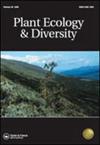热带安第斯山脉海拔3000米梯度山地次生林的最低温度驱动群落叶片性状变化
IF 1.6
4区 生物学
Q2 PLANT SCIENCES
引用次数: 10
摘要
摘要背景:叶功能性状(LFT)影响资源获取,对理解生态系统过程具有重要意义。气候和土地利用是群落组成和LFT的关键过滤器,然而,安第斯山脉很少研究这些过滤器随海拔变化的相对重要性。目的:深入了解安第斯森林对自然再生林分中气候和干扰的功能反应。方法:在海拔3000米的样带上,测量了13个次生林群落的叶片厚度(LBT)、叶面积(LA)、比叶面积(SLA)和叶片干物质含量(LDMC)。我们推导了基底面积加权平均群落(CWM)特征值,以评估气候和干扰对再生树木群落功能结构的影响。结果:在温度变化和演替阶段的驱动下,群落LFT沿海拔梯度逐渐向叶片较厚、SLA较低的群落转移。LDMC随海拔高度的降低表明肉质和硬叶性是这些森林的重要策略。结论:我们的研究结果加强了LFT作为一个强有力的预测因子的有效性,以探索气候情景下树种的生态策略。气候变暖可能导致在高海拔地区从较慢的资源获取策略转向较快的资源获取战略。本文章由计算机程序翻译,如有差异,请以英文原文为准。
Minimum temperature drives community leaf trait variation in secondary montane forests along a 3000-m elevation gradient in the tropical Andes
ABSTRACT Background: Leaf functional traits (LFT) influence resource acquisition and are important for understanding ecosystem processes. Climate and land use are key filters of community composition and LFT, however, how the relative importance of these filter changes with elevation has been little studied in the Andes. Aims: To gain insight into the functional response of Andean forests to climate and disturbance in naturally regenerated forest stands. Methods: We measured leaf blade thickness (LBT), leaf area (LA), specific leaf area (SLA), and leaf dry matter content (LDMC) from 13 secondary forest communities, along a 3000-m elevation transect. We derived basal area-weighted mean community (CWM) trait values to assess the effect of climate and disturbance on the functional structure of regenerating tree communities. Results: Community LFT progressively shifted along the elevation gradient driven by changes in temperature and successional stages towards communities with thicker leaves with low SLA. Reduction in LDMC with elevation suggested that both succulence and sclerophylly were important strategies in these forests. Conclusions: Our findings reinforce the validity of LFT as a powerful predictor to explore the ecological strategies of tree species in climate scenarios. Warmer conditions could result in a shift from slower to faster resource acquisition strategies at higher elevations.
求助全文
通过发布文献求助,成功后即可免费获取论文全文。
去求助
来源期刊

Plant Ecology & Diversity
PLANT SCIENCES-
CiteScore
3.30
自引率
0.00%
发文量
26
审稿时长
3 months
期刊介绍:
Plant Ecology and Diversity is an international journal for communicating results and novel ideas in plant science, in print and on-line, six times a year. All areas of plant biology relating to ecology, evolution and diversity are of interest, including those which explicitly deal with today''s highly topical themes, such as biodiversity, conservation and global change. We consider submissions that address fundamental questions which are pertinent to contemporary plant science. Articles concerning extreme environments world-wide are particularly welcome.
Plant Ecology and Diversity considers for publication original research articles, short communications, reviews, and scientific correspondence that explore thought-provoking ideas.
To aid redressing ‘publication bias’ the journal is unique in reporting, in the form of short communications, ‘negative results’ and ‘repeat experiments’ that test ecological theories experimentally, in theoretically flawless and methodologically sound papers. Research reviews and method papers, are also encouraged.
Plant Ecology & Diversity publishes high-quality and topical research that demonstrates solid scholarship. As such, the journal does not publish purely descriptive papers. Submissions are required to focus on research topics that are broad in their scope and thus provide new insights and contribute to theory. The original research should address clear hypotheses that test theory or questions and offer new insights on topics of interest to an international readership.
 求助内容:
求助内容: 应助结果提醒方式:
应助结果提醒方式:


